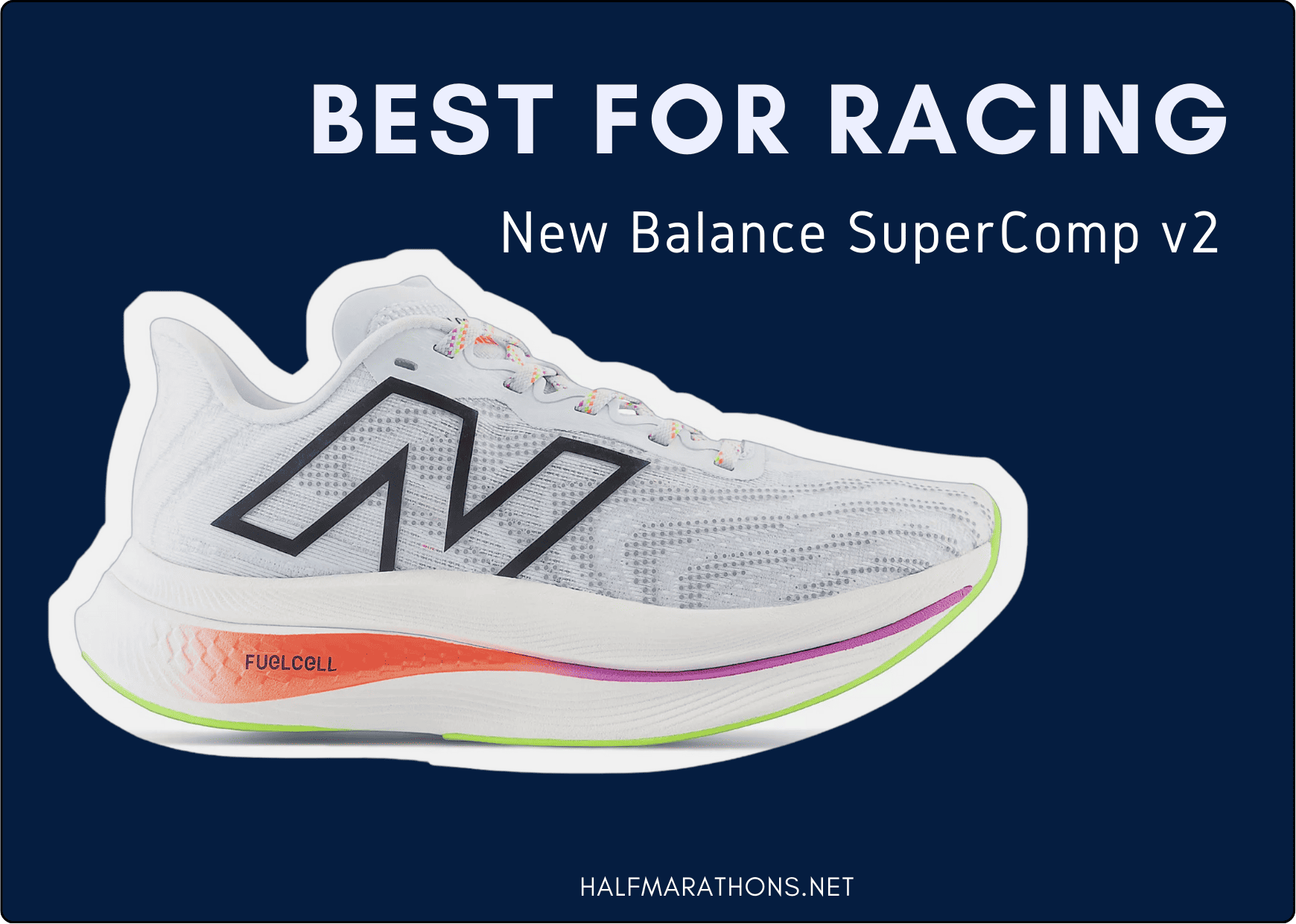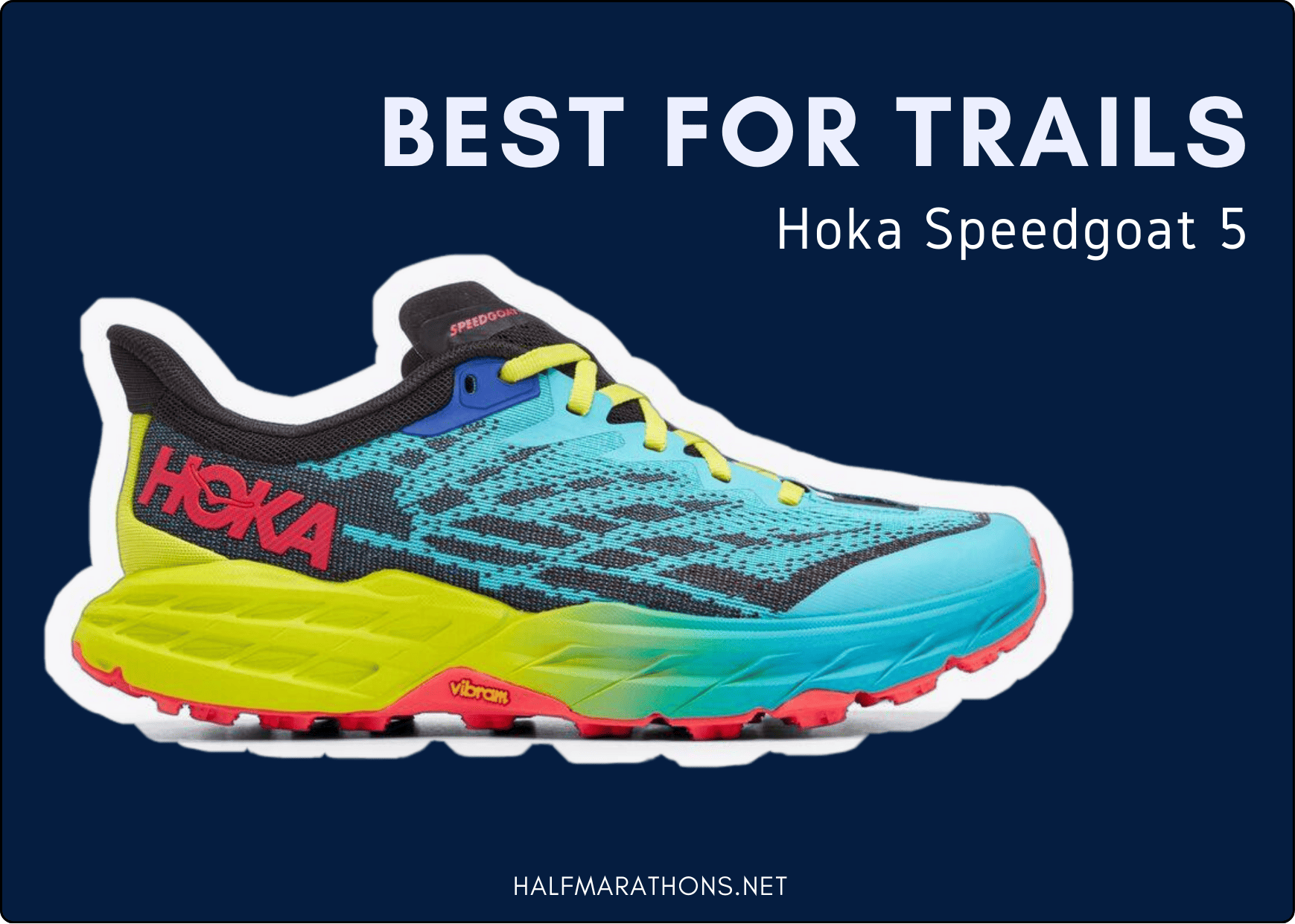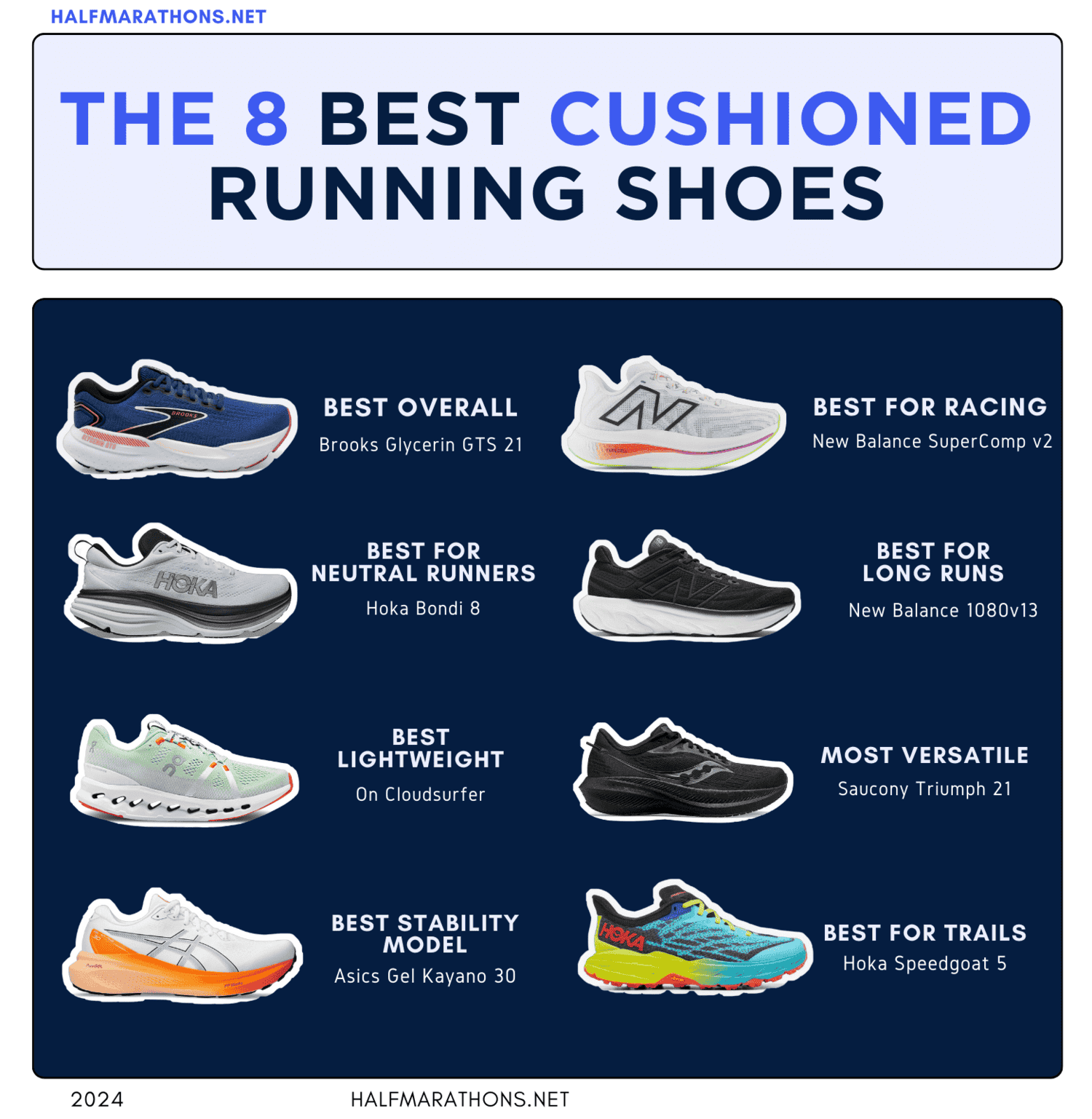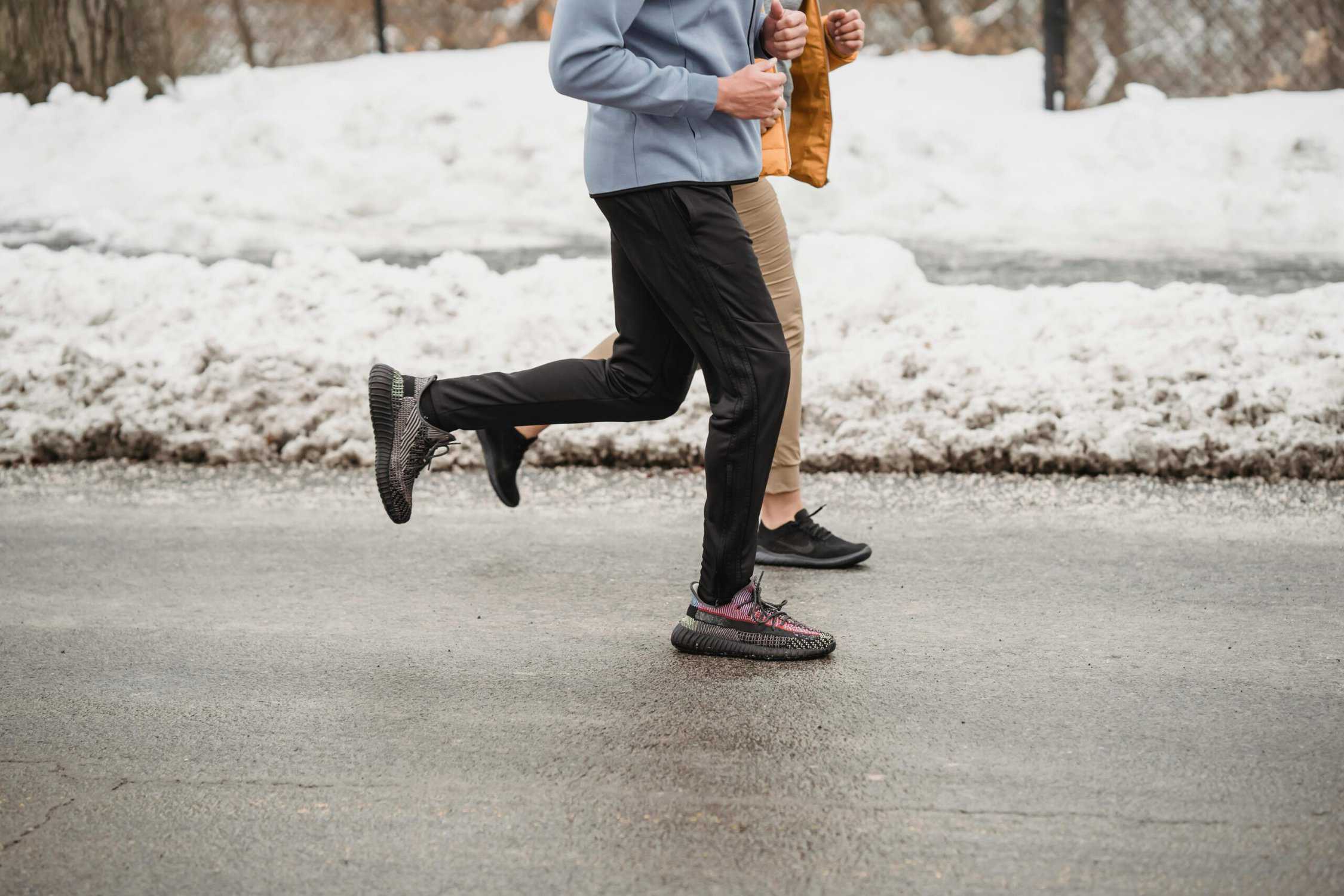While carbon plated shoes certainly have their place in helping people reach PRs, it’s your everyday training shoes that really make or break your training cycle. And if you like a soft or plush ride underfoot, or you have a history of injuries, your lower body may be happiest in a high-quality, best cushioned running shoes.
Cushioned running shoes are super effective at shock absorption, making them a fan favorite among anyone with, in particular, stress injuries. But they’re also a top choice among runners who prefer a well-cushioned shoe for everyday runs over a minimalist ride.
The best cushioned running shoes available today all look and feel a little different. Whether you like a lightweight bounce to propel you forward or a bed-like plushness to keep you comfortable on long miles, there’s a cushioned running shoe option for racing, training, trail, and more — plus each has a different type of cushion and support, so you can find the right combo for your individual gait.
Since the best cushioned running shoe is highly individual, I’ve used my expertise as a runner and gear tester to narrow down some of my favorite models, while also considering shoes that have received glowing reviews from customers. Check out our top picks for the best cushioned running shoes of 2024.

The Best Cushioned Running Shoes of 2024
- Best Overall: Brooks Glycerin GTS 21
- Best for Neutral Runners: Hoka Bondi 8
- Best Lightweight: On Cloudsurfer
- Best Stability Model: Asics Gel Kayano 30
- Best for Racing: New Balance SuperComp v2
- Best for Long Runs: New Balance 1080v13
- Most Versatile: Saucony Triumph 21
- Best for Trails: Hoka Speedgoat 5

Best Overall
Brooks Glycerin GTS 21
Key Specs:
- Weight: 10.5 oz
- Type: Road
- Drop: 10mm
- Stack Height: 28mm
- Support Level: Adaptive stability
Pros:
- Very cushioned
- Adaptable support is great for all gaits
- Great for everyday training
- Breathable upper
Cons:
- Not a lot of color options
- Feels different than the previous model, which some customers may not like (though we do)
The Glycerin GTS is one of my go-to’s when recommending not only high-cushion shoes but also running shoes in general. It offers high levels of cushioning without feeling bulky or too soft.
The Glycerin uses the DNA Loft v3 foam which is a nitrogen-infused foam known for its durability and soft, bouncy feel. The 21 upgraded quite a bit from its predecessors by adding more foam for a plusher feel, though this shoe still has a bit more of a ground-feel compared to something like the Hoka Bondi. I also love that, although there’s more cushion, Brooks still managed to drop the weight of the shoe.
One of the reasons I recommend the Brooks Glycerin GTS 21 as the best cushioned running shoe for most people is because of its guide rail stability system, which supports the foot from both sides and helps to keep it in a neutral position while running. This is considered an adaptive-support model as it will only support the foot as much as you need it to — meaning, it won’t affect your gait at all unless you stray from a neutral position.
I also personally love Brooks for its outsoles. I have found them to be grippier and more durable than other brands, which makes them a great multi-surface shoe, even in wet conditions.
Since this are a newer model, there aren’t a ton of color options yet, and some sizes may be sold out. But as we progress further into the year, more color options and stock should become available if you can’t find what you are looking for now.

Best for Neutral Runners
Hoka Bondi 8
Key Specs:
- Weight:10.8 oz
- Type: Road
- Drop: 4mm
- Stack Height: 39mm
- Support Level: Neutral
Pros:
- Max cushion
- Lightweight
- Many widths
- Many color options
Cons:
- Pretty bulky
- Many people do not care for the look of the shoe
- Not ideal for severe overpronators
The Hoka Bondi is one of the most sought after pairs of high-cushioned running shoes. Beloved for its cloud-like feel and max cushion, these running shoes are excellent at shock absorption. This shoe uses a full EVA foam midsole which allows it to feel both highly cushioned and lightweight.
It is technically a neutral shoe (though it pairs well with inserts if you need additional support), which makes it a great option for most runners, but not severe overpronators — which is the main reason it didn’t beat out the competition for Best Overall shoe.
Despite being one of the most max cushion shoes on our list, the Bondi is still relatively stable thanks to a flared base in the heel and forefoot of the shoe. This helps to prevent the foot from rolling, and gives you a more even footfall on uneven ground.
The slight upturn of the heel and toe of this shoe also allow you to roll smoothly from heel to toe, and the rear crash pad is especially great for heel strikers.
The main complaint about this shoe is its sheer bulk. Though it is pretty lightweight, you will have no ground feel and it can feel a bit clunky especially when you dive into speedwork.

Best Lightweight
On Cloudsurfer
Key Specs:
- Weight: 8.6 oz
- Type: Road
- Drop: 10mm
- Stack Height: 37mm
- Support Level: Neutral
Pros:
- Stunning design
- Very lightweight
- Breathable upper
- Responsive feel
Cons:
- Some may find it too soft
- Only works for neutral runners
With many cushioned running shoes, you have to pick between soft, plush cushioning and a light weight underfoot. The On Cloudsurfer, however, manages to deliver both.
However soft you think this shoe is, I can pretty much guarantee that it’s softer. It uses On’s signature pods, which contract on impact and rebound as you take off for a responsive feel. They’re made of Helion foam which is designed to provide incredibly soft cushion, durability, and support.
Unlike most of On’s other models, the Cloudsurfer ditched its signature speedboard. This allows it to drop weight from the previous model and give the shoe a more flexible feel overall. It also has a lightweight, super-breathable mesh upper that is free of plastic overlay and even includes some recycled materials.
While I do believe that there are many runners that would consider this to be the perfect shoe, it’s not going to work for everyone. It’s a neutral shoe, for one. And if you are someone with joint issues, a history of stress injuries, or you overpronate severely, you will want to opt for a more protective, more supportive shoe.

Best Stability Model
Asics Gel Kayano 30
Key Specs:
- Weight: 9.3 oz
- Type: Road
- Drop: 10mm
- Stack height: 40mm
- Support Level: Stability
Pros:
- Adaptive support
- Very soft cushioning
- Great for heel strikers
- Sock-like tongue
- Lighter weight
Cons:
- Expensive
- High stack height can make it feel bulky
Love it or hate it, the Asics Gel Kayano has been a staple in the running community for decades. But the newest model has ditched its predecessor’s reputation of being heavy, stiff, and not ideal for speed days. The newest model of the Kayano is fully on-board the trend of adaptive stability and lighter, softer cushioning.
This shoe uses a 4D guidance system which adjusts to your levels of pronation during your run. This means that it is able to provide more support when you need it and less when you don’t, making it a great option for neutral runners, overpronators, and everyone in between. I also love it as a long-run shoe, able to support your gait as it deteriorates over long miles without affecting your gait at the beginning of your run.
This version of the Kayano also uses more of a softer foam, but managed to keep the Asics gel in the heel so it remains a good choice for heel strikers or those with heavy foot falls.
Since Asics added a bit more foam to this generation of Kayano, however, this shoe does sit pretty high off the ground. If you like a ground feel or more bounce than squish, this isn’t the shoe for you.

Best for Racing
New Balance SuperComp v2
Key Specs:
- Weight: 10 oz
- Type: Road racing
- Drop: 6mm
- Stack Height: 40mm
- Support Level: Neutral
Pros:
- Super soft but also responsive
- Breathable, lightweight upper
- Great for both racing and training
- More cushion than most racing shoes
Cons:
- Expensive
- Runs narrow in the toe box
- Won’t last as long as most trainers
Most super shoes tend to be on the higher cushion side of the spectrum, but the New Balance’s racing shoe, the SuperComp v2, is particularly plush and can serve as both a racer and a trainer.
Its midsole is made up of two layers of the brand’s FuelCell foam which is incredibly lightweight and soft without being squishy. To give the SuperComp a snappy, responsive feel, a full-length carbon fiber plate is sandwiched between the two layers. And since there is a thick layer of foam between the plate and the bottom of the foot, this shoe feels softer than many carbon-plated models without sacrificing speed.
The upper of the shoe is made from a breathable, lightweight mesh which helps to cut down weight while still allowing for a full coverage, high grip outsole that helps prevent wear over long miles.
Though this shoe is still pretty girthy with a 40mm stack height, it did drop 7mm from the last model, and with an update to the midsole design, it provides maximum cushion without unnecessary weight or height.
The biggest downside of this shoe would have to be the durability. Yes, it will last you longer than most carbon racers, but for most people, it won’t have the longevity of your everyday trainers, which can be a hard pill to swallow for the price of $180.

Best for Long Runs
New Balance 1080v13
Key Specs:
- Weight: 9.2 oz
- Type: Road running
- Drop: 6mm
- Stack Height: 38mm
- Support Level: Neutral
Pros:
- Soft and supportive
- Great shock absorption
- Supportive, breathable upper
- Good grip
Cons:
- Limited stock
- Runs narrow in the toe box
- Not ideal for severe overpronators
The 1080 has gone through quite the transformation in the past six or so years, when I first started running in this model. And while it did seem to stray for a bit, the 1080v13 has come back with a vengeance as one of the best high cushion running shoes on the market.
With more cushion and a firmer feel than the last couple models, this shoe provides a smooth, plush ride without feeling squishy or muddy. Not only does this come from the super soft Fresh Foam X, but the 1080v13 also has a rocker profile to help with that heel-to-toe motion and allow for a smooth transition with every step.
This model also went back to a mesh upper which provides better support than the stretchy, knit uppers New Balance has used for the last couple generations. Since the foam itself is softer, the mesh upper helps to balance out the plushness of the shoe and give the support you need without it feeling constricting.
Unfortunately, this shoe is somewhat limited as far as the stock right now with restricted color options, and some sizes completely out of stock. Since it is on the softer side, and it is as neutral as neutral can be, this also isn’t the best pick for severe overpronators, even with the addition of an insole.

Most Versatile
Saucony Triumph 21
Key Specs:
- Weight: 8.8 oz
- Type: Road
- Drop: 10mm
- Stack Height: 38mm
- Support Level: Neutral
Pros:
- Durable and responsive foam
- Great for all types of runs
- Grippy outsole
- Cushioned but breathable upper
Cons:
- Runs narrow
- Certain sizes have laces that are too short for the shoes
The Saucony Triumph is one of my personal top choices for a high-cushioned running shoes — in fact it was my race day shoe for the Boston Marathon last year. I chose it, then and now, for a couple reasons: It is incredibly responsive, very durable, and provides enough cushion and protection against pounding long miles.
This shoe uses a TPU bead foam which is known for its durability and bouncy feel. Because of the high level of energy return, the shoe feels as if it is propelling you forward and helps to quicken your cadence and decrease your ground contact time which also in turn decreases shock.
The upper of the shoe has also improved greatly over the last couple generations with a soft and breathable mesh upper, and amply padded heel and tongue which help to prevent blisters and hotspots. Though this is a neutral shoe, the firmer foam gives it a bit more support than some comparable models, and gives insoles a solid base to sit on.
The biggest complaint with this shoe is that it does run a bit narrow, and especially with higher volume feet, it can feel a bit snug.

Best for Trail Running
Hoka Speedgoat 5
Key Specs:
- Weight: 8.5 oz
- Type: Trail
- Drop: 4mm
- Stack Height: 33mm
- Support Level: Neutral
Pros:
- Responsive cushioning
- Breathable upper
- Grippy Vibram sole
- Lightweight
Cons:
- Runs narrow
- Limited colors in stock
While running most trails are easier on the legs than running on roads or sidewalks, many of us still prefer a good amount of cushion. The tricky part is finding a well-cushioned trail running shoe that doesn’t sacrifice stability, durability, or grip.
The Speedgoat is that unicorn. It’s one of the trail shoes that provides ample cushioning while still being able to handle the most technical trails, securely. It uses a midsole foam that is particularly responsive — I would even go so far as to call it bouncy — which is great for footfall on both harder surfaces like rock and spongier ones like grass and mud.
To give it grip, this shoe uses a Vibram outsole which prevents slippage on both dry and wet conditions. It also has 5mm lugs that grip into the ground without picking up dirt, mud, or small rocks. While it’s not waterproof, it is well ventilated and will keep your feet dry and cool even on the hottest, sweatiest days.
The biggest complaint with these is that they run a bit narrow, and unfortunately they only come in regular width. So if you have a wider foot, you’ll be best served to go up a half size.
What to Look for in the Best High Cushion Running Shoes
When looking for a high-cushion running shoe, the most important features to consider are:
- Drop: The measure between the height of the toe and heel of the shoe, most drops range from 0-12 mm. A zero- or low-drop shoe keeps your foot close to the barefoot position, giving you a more natural feel when you run, like Altra’s cushioned models. Some people prefer a higher drop with more cushioning in back of the shoe — especially heel strikers — as many find it relieves pressure on the achilles. The best drop comes down to personal preference and biomechanics.
- Stability: Running shoes are generally either considered to be ‘stability’ or ‘neutral’. A neutral shoe will allow you to run without altering your gait while a stability shoe will offer support to guide you into a neutral (optimal) position if your foot naturally rolls in or out (overpronates). While most people can run in a neutral shoe, it is recommended by running fit specialists as well as most physical therapists that those with a history of injuries or moderate to severe overpronators opt for a stability model. If you do find a neutral shoe that you love, you can always add additional support with an insole.
- Type: The cushioning level isn’t the only thing that you will have to consider with running shoes. The most important thing to look at is what the shoe is intended for — though it may seem obvious, a trail shoe isn’t made for the concrete jungle, and wearing a carbon plated racer on technical terrain is a recipe for disaster, so always make sure that the shoe you are buying is designed for the places and paces you intend to run.
- Stack Height: This isn’t the most important feature, but it is something to be aware of — especially in high cushion shoes. While not all high-cushion models have super thick soles, some do, and unless you are used to that feeling, you may find a high stack height to be a bit bulky. If you have been running in lower-cushion shoes, try a lower stack height — 32-35mm — first so that it’s less of an adjustment.
- Weight: The weight of a shoe isn’t a crucial factor, but the more you train, the more of a difference this will make. High-cushion shoes are often on the heavier side, but that doesn’t necessarily mean the shoe will feel heavy underfoot. Arguably, the material is more important than the weight; sometimes more responsive foams are slightly heavier but feel faster thanks to the energy return, compared to a lighter-weight shoe.
FAQs
Are High Cushion Shoes Better Than Mid or Low Cushion Shoes?
To decide the amount of cushion that you need in your running shoes, the most important thing to consider is feel. But while high cushion shoes will provide you with a softer, plusher ride underfoot, they are also the best at shock absorption, and are the suggested pick for anyone that suffers from running related aches and pains — particularly in the legs and feet.
Are All High Cushion Running Shoes the Same?
Though all high cushion shoes will provide, well, a high level of cushioning, that’s about where the similarities end. Besides small differences between brands like materials, fit, and style, there are also different kinds of high cushion running shoes — think road running, racing, trail running — and of course differences in support with both neutral and stability shoes. When choosing a high cushion running shoe, these are also important factors to consider.
Why Are High Cushion Running Shoes so Expensive?
These shoes are usually made not only with higher quality foams, but also more of them. Because of that, the price goes up a bit when compared to a mid-cushion shoe, but the upside is that these do tend to eke out a bit more mileage than lower cushion shoes — especially if you are wearing them more for comfort than necessity.
Why Trust Us
Gabrielle began her writing career in 2019 with a fellowship for Runner’s World Magazine and was Commerce Editor for the publication until 2023. She is now freelancing full time and specializes in everything health, wellness and fitness. Gabrielle also ran on the track and cross country teams at Muhlenberg college, and always has more than one high cushion shoe in her running shoe rotation.
–
Everything featured on Half Marathon Guide is independently selected and curated. We may receive a small commission on purchases made from some of our links.





